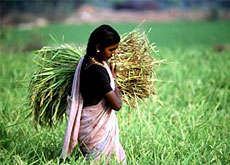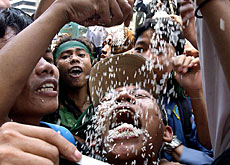Year of Rice offers a grain of hope

Rice is a staple food for half the world’s population, and also plays a key role in society and the economy.
The United Nations International Year of Rice 2004 is aimed at highlighting the cereal’s importance in the fight against poverty. In Switzerland it has triggered a discussion about fair trade.
In Thailand, they say “kin khao”, in China “chi fan”, in Myanmar “tamin sa deh” and in Vietnam “an chom”. Every country has a word in its vocabulary to express humanity’s primary need to eat.
The peculiarity of Asian languages lies in the fact that the word for “rice” is always associated with the verb “to eat” – suggesting an age-old link between humanity and the precious cereal.
Energy source
Rice is the principal food for half the world’s population. Made up for the most part of carbohydrates, rice supplies a quarter of the energy needs of developing countries.
“Rice is grown mainly for local consumption,” notes Hans-Peter Egler, who works at the Swiss State Secretariat for Economic Affairs (Seco).
Egler, the head of trade cooperation and clean technology transfer, adds that only 15 per cent of the world’s crop is exported.
Farmed in 113 countries, rice grows on all the continents except Antarctica. The plant – originally from Asia – is equally at home in rainy or more arid zones, and has put down roots in the most diverse environments, including forests, deserts, coastal areas and mountainsides.
More rice, less poverty
Devoting a year to the celebration of just one cereal is unprecedented in the history of the UN.
The International Year of Rice 2004, promoted by the Food and Agriculture Organisation (FAO) and the International Rice Research Institute (IRRI), is much more than just a tribute to the cereal’s many virtues. The initiative aims to aid the struggle against poverty and to safeguard the environment.
Under the slogan “Rice is Life”, the IRRI campaign has set itself the aim of promoting rice production. The campaign’s premise is that a sustainable increase in production will mean less hunger, less poverty and thus a better quality of life.
“In addition to its purely nutritional qualities, rice is a crop that offers work opportunities. It is a key element in a country’s economic growth,” explains Egler.
In rural districts of developing countries, rice growing provides work for almost one billion people. Interestingly, four-fifths of the world’s crop comes from small-scale farms.
Where the cereal is farmed, there is often greater biodiversity. Rice growing can be combined well with other activities, such as farming fish and ducks in the rice fields.
Rice straw can be used to feed livestock or build huts.
Terraced rice fields, which are typical of parts of Bali and Vietnam, also help to prevent soil erosion and landslides.
Many varieties
Fenis, Ariete, Drago, Albatros, Pony and Condor: these are not the animals in some bizarre zoo, but the names of a few of the world’s many kinds of rice.
In the past, there were about half a million varieties, but today there are “only” 140,000.
Rice growing has expanded considerably around the world in the past 15 years, from 135 million hectares to about 148 million.
Over the same period, the global harvest has risen by more than 44 per cent.
Fair trade
The International Year of Rice is also an opportunity to discuss fair trade.
“We want to inform the public about the importance of sustainable development, and to open the Swiss market to products from developing countries,” states Guido Münzel, head of communications at claro fair trade.
This Seco-sponsored Swiss company works directly with growers in Southeast Asia, where it promotes production of new varieties to export to the industrialised world.
One of the items distributed by claro as part of its awareness-raising campaign is a pyramid-shaped package containing five varieties of rice from Thailand and Laos.
“It’s one way to introduce people to the varieties that are less well-known in our part of the world,” adds Münzel.
swissinfo, Luigi Jorio
In 2002, 576 million tons of rice were produced around the world.
40,000 tons were imported into Switzerland.
96kg of rice per person are consumed in China each year.
By comparison just 5.5kg per person are consumed in Switzerland.
Rice comes originally from Southeast Asia, where it has been farmed intensively for more than 7,000 years.
It was the Arabs who spread its consumption and cultivation in the Mediterranean basin.
Rice is the most widely consumed cereal in the world, and grows in Egypt, Italy, Switzerland, the United States and Brazil, as well as Southeast Asia.

In compliance with the JTI standards
More: SWI swissinfo.ch certified by the Journalism Trust Initiative


You can find an overview of ongoing debates with our journalists here. Please join us!
If you want to start a conversation about a topic raised in this article or want to report factual errors, email us at english@swissinfo.ch.